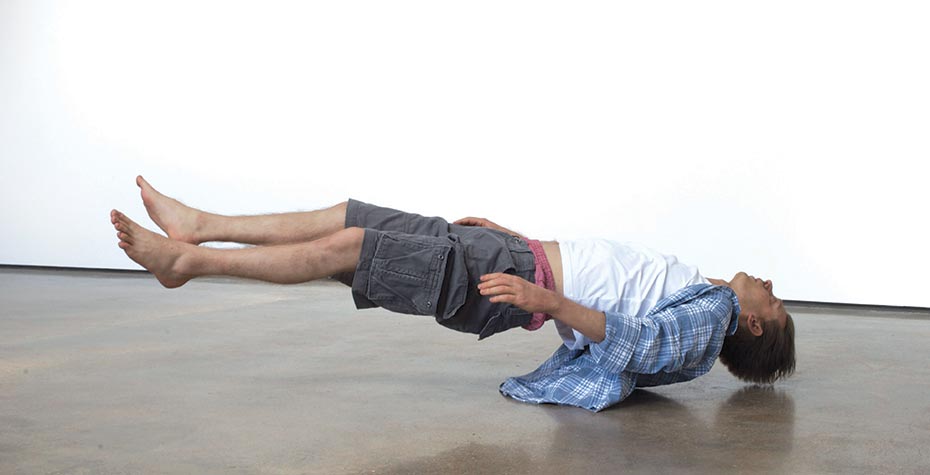See Astonishing Works by Sculptor Tony Matelli and by Artists from Venice's Heyday

Tony Matelli: New Gravity, the first solo exhibition in a U.S. museum by the eponymous sculptor, opens Thursday, February 6, at the Davis Museum. Please note, due to inclement weather, the opening has been delayed from its original date of February 5.
Matelli’s work, according to the nonprofit alternative art institution White Flag Projects, is invested “with layers of familiarity and discomfort.” The artist combines remarkable realism with a “darkly comic approach to the function of his subjects within the specific context of the gallery. [Matelli] suspends time and disbelief, pausing images both unlikely and mundane in moments of peculiar aesthetic tension.”
“Tony Matelli is a trader in combinatory illusions, a skilled manipulator of the restless mediation between metaphor, meaning, and truth,” said Lisa Fischman, Ruth Gordon Shapiro ’37 Director of the Davis and curator of the exhibition. “His works are persistently surprising, inventive, powerful and playful—evoking complex sensations and inviting multiple viewings. We are delighted to present his first U.S. museum exhibition at the Davis and to introduce New England audiences to his work.”
Often employing a hyper-realistic idiom, Matelli’s work is designed to challenge perceptions of reality (see Josh, a sculpture of a man who appears to levitate, which will be displayed on the Davis’s top level and was recently featured in the Boston Globe.)
“There is a romantic impulse in my work that strives to give form to my emotions and thoughts and the way I see the world,” Matelli said. “I’m fascinated with that moment when you become aware of a perceptual shift in your environment, so what was a seemingly real-life experience becomes a complicated art experience.”
The majority of Matteli’s work that is on display at Wellesley will be inside the Davis, but the exhibition also includes two outdoor works. The outdoor sculptures, Sleepwalker and Stray Dog, have already generated a great deal of conversation on campus and on social media. Sleepwalker, in particular, has elicited a range of responses.
“As a work of art, Sleepwalker is operating the way it should, eliciting a variety of reactions and questions from viewers: Is it real? What is it doing there?” said Nikki A. Greene, assistant professor of art. “After you realize it is a sculpture, Sleepwalker invites you to think about how this outdoor installation relates to the work inside.”
Greene, an art historian who examines African and African American identities, music, the body, and feminism in 20th century and contemporary art, said she is excited to see “how what’s inside New Gravity connects to what’s outside the exhibit—and in particular, the connection between Sleepwalker and Josh.”
“Art has the ability to invite the kinds of conversation that are not easily available anywhere else but in the art world,” said Greene. “Sleepwalker can even do some of the work in sparking the kinds of dialogue that we want to have on campus. The fact that people are talking about this sculpture means a lot, and whether people respond positively or negatively, it is valuable to have these conversations.”
Lisa Fischman says “As the best art does, Tony Matelli’s work provokes dialogue, and discourse is at the core of education.” For those on campus interested in adding their voices to the conversation, look for the posters in the Lulu Chow Wang Campus Center and add your thoughts. The community is also invited to hear from the artist directly at an artist talk by Matelli at 5:30 p.m. on Thursday, February 6, and to the opening reception that follows from 6:30-8 p.m.
Tony Matelli: New Gravity will be on view February 6 through May 11, in the Bronfman & Chandler Galleries, and February 6 through July 20 in the Jobson & Tanner Galleries at the Davis. The exhibition is free and open to the public.
More at the Davis
Figment of the Past: Venetian Works on Paper from the Davis, an exhibit celebrating the Davis Museum’s rich holdings of early modern Venetian works on paper from the 16th century to the end of the Republic of Venice (1797), also opens this week. Inspired by the extraordinary city during a period in which Venice ruled as an economic and artistic powerhouse, the exhibition displays 25 works by artists including, among others, Palma il Giovane, Canaletto, and Tiepolo. On view February 5 through May 4.
Figment of the Past: Venetian Works on Paper is presented with generous support from the Marjorie Schechter Bronfman ’38 and Gerald Bronfman Endowment for Works on Paper.
